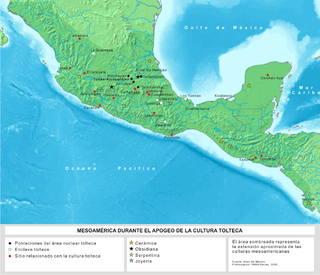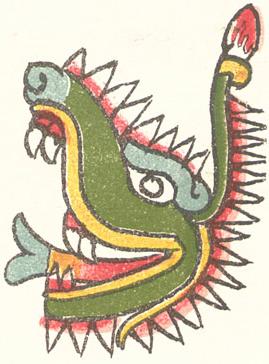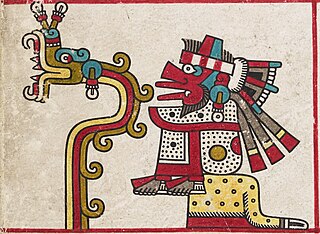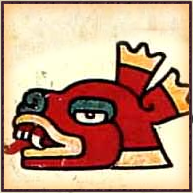Related Research Articles

The Toltec culture was a pre-Columbian Mesoamerican culture that ruled a state centered in Tula, Hidalgo, Mexico, during the Epiclassic and the early Post-Classic period of Mesoamerican chronology, reaching prominence from 950 to 1150 CE. The later Aztec culture considered the Toltec to be their intellectual and cultural predecessors and described Toltec culture emanating from Tōllān as the epitome of civilization. In the Nahuatl language the word Tōltēkatl (singular) or Tōltēkah (plural) came to take on the meaning "artisan". The Aztec oral and pictographic tradition also described the history of the Toltec Empire, giving lists of rulers and their exploits.

Aztec mythology is the body or collection of myths of the Aztec civilization of Central Mexico. The Aztecs were Nahuatl-speaking groups living in central Mexico and much of their mythology is similar to that of other Mesoamerican cultures. According to legend, the various groups who were to become the Aztecs arrived from the north into the Anahuac valley around Lake Texcoco. The location of this valley and lake of destination is clear – it is the heart of modern Mexico City – but little can be known with certainty about the origin of the Aztec. There are different accounts of their origin. In the myth the ancestors of the Mexica/Aztec came from a place in the north called Aztlan, the last of seven nahuatlacas to make the journey southward, hence their name "Azteca." Other accounts cite their origin in Chicomoztoc, "the place of the seven caves", or at Tamoanchan.
Mayan or Maya mythology is part in of Mesoamerican mythology and comprises all of the Maya tales in which personified forces of nature, deities, and the heroes interacting with these play the main roles. The legends of the era have to be reconstructed from iconography. Other parts of Mayan oral tradition are not considered here.

Qʼuqʼumatz was a god of wind and rain of the Postclassic Kʼicheʼ Maya. It was the Feathered Serpent that according to the Popol Vuh created the world and humanity, together with the god Tepeu. It carried the sun across the sky and down into the underworld and acted as a mediator between the various powers in the Maya cosmos. It is considered to be the equivalent of the Aztec god Quetzalcoatl and of Kukulkan, of the Yucatec Maya.

Tezcatlipoca or Tezcatl Ipoca was a central deity in Aztec religion. He is associated with a variety of concepts, including the night sky, hurricanes, obsidian, and conflict. He was considered one of the four sons of Ometecuhtli and Omecihuatl, the primordial dual deity. His main festival was Toxcatl, which, like most religious festivals of Aztec culture, involved human sacrifice.

In Aztec mythology, Xolotl was a god of fire and lightning. He was commonly depicted as a dog-headed man and was a soul-guide for the dead. He was also god of twins, monsters, death, misfortune, sickness, and deformities. Xolotl is the canine brother and twin of Quetzalcoatl, the pair being sons of the virgin Chimalma. He is the dark personification of Venus, the evening star, and was associated with heavenly fire. The axolotl is named after him.

Mixcoatl, or Camaxtle or Camaxtli, was the god of the hunt and identified with the Milky Way, the stars, and the heavens in several Mesoamerican cultures. He was the patron deity of the Otomi, the Chichimecs, and several groups that claimed descent from the Chichimecs. Under the name of Camaxtli, Mixcoatl was worshipped as the central deity of Huejotzingo and Tlaxcala.

Cipactli was the first day of the Aztec divinatory count of 13 X 20 days and Cipactonal "Sign of Cipactli" was considered to have been the first diviner. In Aztec cosmology, the crocodile symbolized the earth floating in the primeval waters. According to one Aztec tradition, Teocipactli "Divine Crocodile" was the name of a survivor of the flood who rescued himself in a canoe and again repopulated the earth. In the Mixtec Vienna Codex, Crocodile is a day associated with dynastic beginnings.

Popol Vuh is a text recounting the mythology and history of the Kʼicheʼ people of Guatemala, one of the Maya peoples who also inhabit the Mexican states of Chiapas, Campeche, Yucatan and Quintana Roo, as well as areas of Belize, Honduras and El Salvador.

In creation myths, the term "Five Suns" refers to the belief of certain Nahua cultures and Aztec peoples that the world has gone through five distinct cycles of creation and destruction, with the current era being the fifth. It is primarily derived from a combination of myths, cosmologies, and eschatological beliefs that were originally held by pre-Columbian peoples in the Mesoamerican region, including central Mexico, and it is part of a larger mythology of Fifth World or Fifth Sun beliefs.

K’uk’ulkan, also spelled Kukulkan, is the serpent deity of Maya mythology. It is closely related to the deity Qʼuqʼumatz of the Kʼicheʼ people and to Quetzalcoatl of Aztec mythology. Prominent temples to Kukulkan are found at archaeological sites in the Yucatán Peninsula, such as Chichen Itza, Uxmal and Mayapan.

The Aztec religion is a polytheistic and monistic pantheism in which the Nahua concept of teotl was construed as the supreme god Ometeotl, as well as a diverse pantheon of lesser gods and manifestations of nature. The popular religion tended to embrace the mythological and polytheistic aspects, and the Aztec Empire's state religion sponsored both the monism of the upper classes and the popular heterodoxies.

The Feathered Serpent is a prominent supernatural entity or deity, found in many Mesoamerican religions. It is still called Quetzalcoatl among the Aztecs, Kukulkan among the Yucatec Maya, and Q'uq'umatz and Tohil among the K'iche' Maya.

Quetzalcoatl is a deity in Aztec culture and literature. Among the Aztecs, he was related to wind, Venus, Sun, merchants, arts, crafts, knowledge, and learning. He was also the patron god of the Aztec priesthood. He was one of several important gods in the Aztec pantheon, along with the gods Tlaloc, Tezcatlipoca and Huitzilopochtli. The two other gods represented by the planet Venus are Tlaloc and Xolotl.

Dogs have occupied a powerful place in Mesoamerican folklore and myth since at least the Classic Period right through to modern times. A common belief across the Mesoamerican region is that a dog carries the newly deceased across a body of water in the afterlife. Dogs appear in underworld scenes painted on Maya pottery dating to the Classic Period and even earlier than this, in the Preclassic, the people of Chupícuaro buried dogs with the dead. In the great Classic Period metropolis of Teotihuacan, 14 human bodies were deposited in a cave, most of them children, together with the bodies of three dogs to guide them on their path to the underworld.
Mesoamerican religion is a group of indigenous religions of Mesoamerica that were prevalent in the pre-Columbian era. Two of the most widely known examples of Mesoamerican religion are the Aztec religion and the Mayan religion.
Many Mesoamerican flood myths have been documented in written form or passed down through in oral tradition. Some clearly have Torah influences, but others are believed by scholars to represent native flood myths of pre-Columbian origin.
In Aztec mythology, Creator-gods are the only four Tezcatlipocas, the children of the creator couple Ometecuhtli and Omecihuatl "Lord and Lady of Duality", "Lord and Lady of the Near and the Nigh", "Father and Mother of the Gods", "Father and Mother of us all", who received the gift of the ability to create other living beings without childbearing. They reside atop a mythical thirteenth heaven Ilhuicatl-Omeyocan "the place of duality".
Mesoamerican cosmovision or cosmology is the collection of worldviews shared by the Indigenous pre-Columbian societies of Mesoamerica. The cosmovision of these societies was reflected in the ways in which they were organized, such as in their built environment and social hierarchies, as well as in their epistemologies and ontologies, including an understanding of their place within the cosmos or universe. Elements of Mesoamerican cosmovision are reflected in pre-Columbian textual sources, such as the Popol Vuh and the Cuauhtinchan maps, the archeological record, as well as in the contemporary beliefs, values, and practices of Indigenous people, such as the Maya, Nahua, and Purépecha, as well as their descendants. It has been argued that the Day of the Dead ceremony exists as a legacy of Mesoamerican cosmovision.
References
- 1 2 Bierhorst, John (1990). The Mythology of Mexico and Central America. New York: William Morrow and Company, Inc. pp. 67–77. ISBN 0688067212.
- ↑ Taube, Karl A. (1993). Aztec and Maya myths. The Legendary past (1st University of Texas Press ed.). Austin: University of Texas Press. pp. 33–34. ISBN 978-0-292-78130-6.
- ↑ Christenson, Allen (March 1, 2007). Popol Vuh: The Sacred Book of Maya (1 ed.). University of Oklahoma Press. pp. 164–176. ISBN 9780806138398.
{{cite book}}: CS1 maint: date and year (link) - ↑ Uriarte, María (Spring 2006). "THE TEOTIHUACAN BALLGAME AND THE BEGINNING OF TIME". Ancient Mesoamerica. 17 (1): 17–38 – via JSTOR.